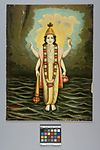About this object
History of use
Indian popular religious prints have been published for nearly a century, first by German presses, later by Indian ones. The prints may take the form of calendars, posters, or simply images. The style of the representations is European. In the beginning they were Hindu images, but are now acquiring elements both of folk art and a romantic secularism. It is a living art currently influenced by the movie industry and non-Hindu religions. The images are a vehicle for advertising and are also used for religious purposes. This one printed in Germany for the South Indian market, then framed and displayed in a prayer room for 'puja' or worship.
Narrative
From collection of calendar prints collected in Southern India.
Cultural context
popular religious art
Iconographic meaning
Vishnu, preserver of the universal order, establishes law and order and protects the world from evil and destruction through ten earthly incarnations. He is identified by: rotating discus; six-petaled lotus; mace symbolizing his power of knowledge; white conch shell; gold crown; and his flying mount, Garuda.
Physical description
Rectangular print depicting Vishnu, a four-armed, dark-haired male, standing on dark green wavy water. Clouded dark green sky meets sea. Clouds clear behind the sunburst yellow halo shape behind male's head. His crown is conical with opening for tuft of hair at top. Male wears floor-length, light yellow dhoti, garland of alternating pink, green, and white flowers, white pearl (?) necklaces, and open pink coat. He holds four objects, one in each hand: gold mace, yellow disc poised on finger, white shell with gold end, and pink lotus. Artist signature, V. H. Pandya in red at bottom left corner.
Categories
Materials
